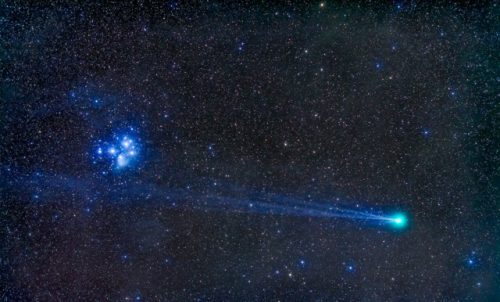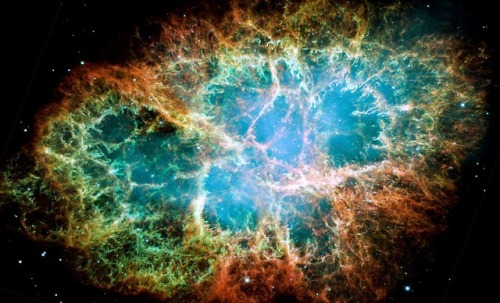Astrosciencechick

More Posts from Astrosciencechick and Others

Thought For The Day

Comet Lovejoy and The Pleiades
why is mercury shrinking?
Unlike the Earth, Mercury’s surface is made up of just one continental plate covering the entire planet, as Mercury’s interior is slowly cooling it also shrinks and the total volume of mercury shrinks.

Celestial Buddy Earth peers out at Mother Earth from the ISS after hitching a ride on this weeks SpaceX Dragon test flight

Comet Lovejoy (C/2014 Q2) streaming through the pale neon sky over Paranal on 20 January 2015. The Pleiades, a tight bundle of electric blue, also appear in the direction of Lovejoy’s tail.
Credit: ESO/G. Hüdepohl (atacamaphoto.com)






some memes I made to express my current frustrations with academia feel free to add your own
It’s only two things.
Imagine where you could be by this time next year. Now do the work

Sharpless 249 and the Jellyfish Nebula : Normally faint and elusive, the Jellyfish Nebula is caught in this alluring telescopic image. Centered in the scene it’s anchored right and left by two bright stars, Mu and Eta Geminorum, at the foot of the celestial twin. The Jellyfish Nebula is the brighter arcing ridge of emission with dangling tentacles. In fact, the cosmic jellyfish is part of bubble-shaped supernova remnant IC 443, the expanding debris cloud from a massive star that exploded. Light from the explosion first reached planet Earth over 30,000 years ago. Like its cousin in astrophysical waters the Crab Nebula supernova remnant, the Jellyfish Nebula is known to harbor a neutron star, the remnant of the collapsed stellar core. An emission nebula cataloged as Sharpless 249 fills the field at the upper left. The Jellyfish Nebula is about 5,000 light-years away. At that distance, this image would be about 300 light-years across. via NASA

The Crab Pulsar (PSR B0531+21) is a relatively young neutron star. The star is the central star in the Crab Nebula, a remnant of the supernova SN 1054, which was widely observed on Earth in the year 1054. Discovered in 1968, the pulsar was the first to be connected with a supernova remnant.

The Crab Pulsar is one of very few pulsars to be identified optically. The optical pulsar is roughly 20 kilometres (12 mi) in diameter and the pulsar “beams” rotate once every 33 milliseconds, or 30 times each second.

The outflowing relativistic wind from the neutron star generates synchrotron emission, which produces the bulk of the emission from the nebula, seen from radio wavesthrough to gamma rays. The most dynamic feature in the inner part of the nebula is the point where the pulsar’s equatorial wind slams into the surrounding nebula, forming a termination shock.

The shape and position of this feature shifts rapidly, with the equatorial wind appearing as a series of wisp-like features that steepen, brighten, then fade as they move away from the pulsar into the main body of the nebula. The period of the pulsar’s rotation is slowing by 38 nanoseconds per day due to the large amounts of energy carried away in the pulsar wind.

The Crab Nebula is often used as a calibration source in X-ray astronomy. It is very bright in X-rays and the flux density and spectrum are known to be constant, with the exception of the pulsar itself.
source | A History of the Crab Nebula
images: NASA/ESA, Hubble, Cambridge University Lucky Imaging Group, NASA/CXC/ASU/J.Hester et al.

55 Nights with Saturn
-
 urbanorama liked this · 4 years ago
urbanorama liked this · 4 years ago -
 theresnoreceptioninpossumsprings liked this · 4 years ago
theresnoreceptioninpossumsprings liked this · 4 years ago -
 siempreadelante reblogged this · 4 years ago
siempreadelante reblogged this · 4 years ago -
 lilyminer liked this · 4 years ago
lilyminer liked this · 4 years ago -
 dontrememberdecember reblogged this · 5 years ago
dontrememberdecember reblogged this · 5 years ago -
 errolheights liked this · 5 years ago
errolheights liked this · 5 years ago -
 beanboo liked this · 5 years ago
beanboo liked this · 5 years ago -
 cthonicstar liked this · 5 years ago
cthonicstar liked this · 5 years ago -
 hippiedad reblogged this · 5 years ago
hippiedad reblogged this · 5 years ago -
 ttonaga liked this · 5 years ago
ttonaga liked this · 5 years ago -
 gizamalblythe liked this · 5 years ago
gizamalblythe liked this · 5 years ago -
 bellsrandomness reblogged this · 5 years ago
bellsrandomness reblogged this · 5 years ago -
 wandering-shepard reblogged this · 5 years ago
wandering-shepard reblogged this · 5 years ago -
 wandering-shepard liked this · 5 years ago
wandering-shepard liked this · 5 years ago -
 dee-daa liked this · 5 years ago
dee-daa liked this · 5 years ago -
 voidw1tch liked this · 5 years ago
voidw1tch liked this · 5 years ago -
 ohhanalou liked this · 6 years ago
ohhanalou liked this · 6 years ago -
 fazbearbrunchie2615 liked this · 6 years ago
fazbearbrunchie2615 liked this · 6 years ago -
 grapegiuce liked this · 6 years ago
grapegiuce liked this · 6 years ago -
 queenofthebuckets reblogged this · 6 years ago
queenofthebuckets reblogged this · 6 years ago -
 queenofthebuckets liked this · 6 years ago
queenofthebuckets liked this · 6 years ago -
 phantom-spiyider liked this · 6 years ago
phantom-spiyider liked this · 6 years ago -
 astrosciencechick reblogged this · 6 years ago
astrosciencechick reblogged this · 6 years ago -
 astrosciencechick liked this · 6 years ago
astrosciencechick liked this · 6 years ago -
 tnezstud reblogged this · 6 years ago
tnezstud reblogged this · 6 years ago -
 bitchycrosstownexpress reblogged this · 6 years ago
bitchycrosstownexpress reblogged this · 6 years ago -
 sirspudd liked this · 6 years ago
sirspudd liked this · 6 years ago -
 geld-sama liked this · 6 years ago
geld-sama liked this · 6 years ago -
 geld-sama reblogged this · 6 years ago
geld-sama reblogged this · 6 years ago -
 kramerica2 liked this · 6 years ago
kramerica2 liked this · 6 years ago -
 tourmaline-56-blog liked this · 6 years ago
tourmaline-56-blog liked this · 6 years ago -
 always-both-at-once-blog liked this · 6 years ago
always-both-at-once-blog liked this · 6 years ago -
 siegfried22 liked this · 6 years ago
siegfried22 liked this · 6 years ago -
 nell-darnel liked this · 6 years ago
nell-darnel liked this · 6 years ago -
 teslalightningthesans-blog liked this · 6 years ago
teslalightningthesans-blog liked this · 6 years ago -
 ctrexfinnadie liked this · 6 years ago
ctrexfinnadie liked this · 6 years ago -
 cannibalgh0st liked this · 6 years ago
cannibalgh0st liked this · 6 years ago -
 esmedoesgeology liked this · 6 years ago
esmedoesgeology liked this · 6 years ago -
 punk--jesus liked this · 6 years ago
punk--jesus liked this · 6 years ago -
 fish-mage liked this · 6 years ago
fish-mage liked this · 6 years ago -
 literaryspacedetective liked this · 6 years ago
literaryspacedetective liked this · 6 years ago